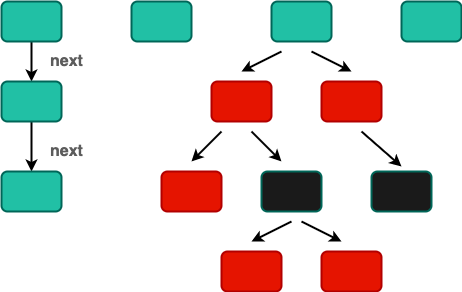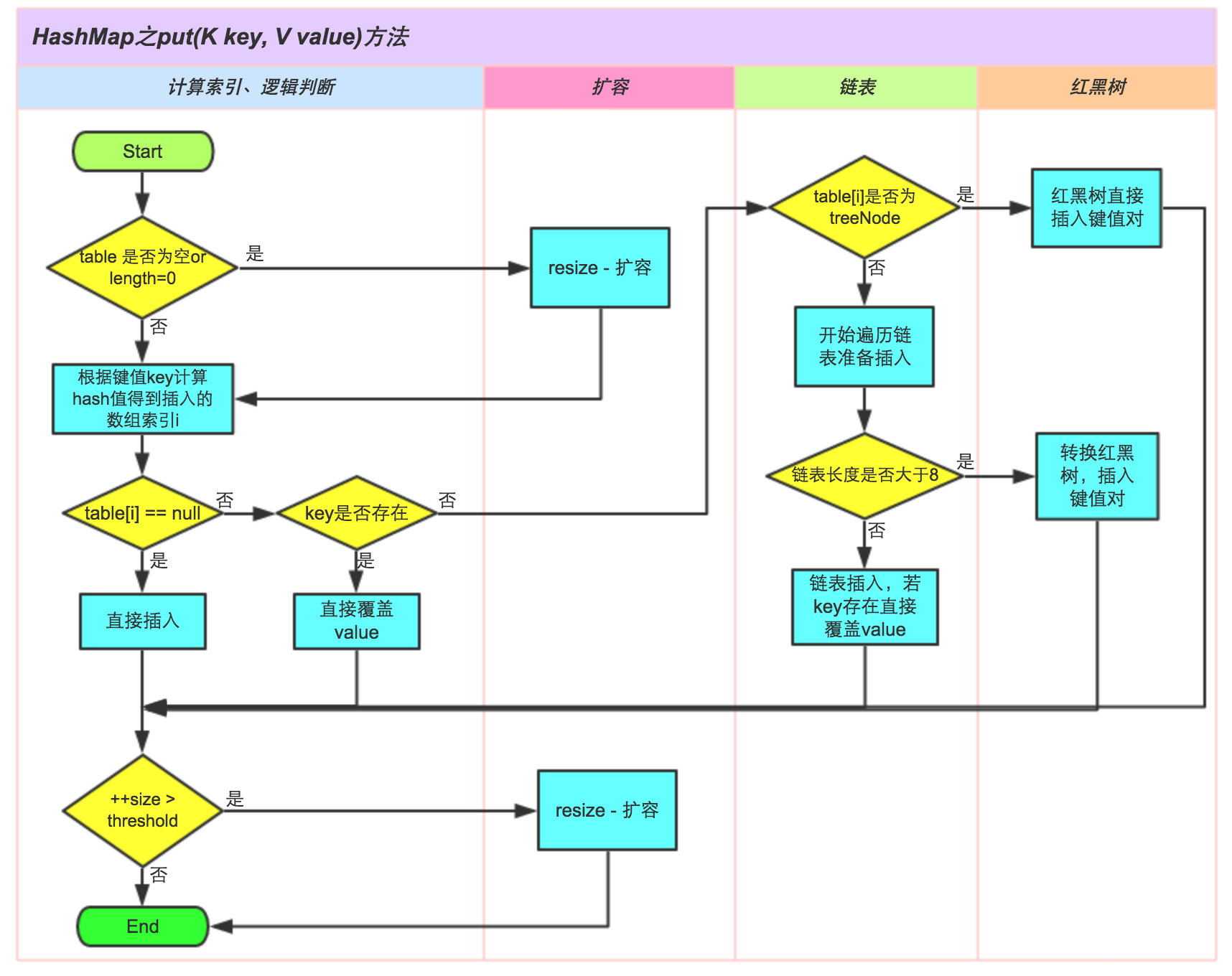HashMap简介 HashMap是一种存储K-V类型的容器,HashMap底层数据结构为数组+链表+红黑树(jdk 1.8新增),它根据键的HashCode值存储数据,获取元素的时间复杂度为O(1)。HashMap非线程安全,即
HashMap是一种存储K-V类型的容器,HashMap底层数据结构为数组+链表+红黑树(jdk 1.8新增),它根据键的HashCode值存储数据,获取元素的时间复杂度为O(1)。HashMap非线程安全,即任一时刻可以有多个线程同时写HashMap,可能会导致数据的不一致,在多线程环境下请使用ConcurrentHashMap。

public class HashMap<K,V> extends AbstractMap<K,V>
implements Map<K,V>, Cloneable, Serializable {
// 默认初始化容量大小为16
static final int DEFAULT_INITIAL_CAPACITY = 1 << 4; // aka 16
// 最大容量
static final int MAXIMUM_CAPACITY = 1 << 30;
// 默认的负载因子为0.75
static final float DEFAULT_LOAD_FACTOR = 0.75f;
// 当链表长度达到8时转换成红黑树
static final int TREEIFY_THRESHOLD = 8;
// 链表长度变为6时红黑树转为链表
static final int UNTREEIFY_THRESHOLD = 6;
// Node类型的table数组
transient Node<K,V>[] table;
// 红黑树时数组最小长度为64
static final int MIN_TREEIFY_CAPACITY = 64;
// 负载因子
final float loadFactor;
}
- 计算 key 的 hash 值,根据 hash 值找到对应数组下标: hash & (length-1)
- 判断数组该位置处的元素是否刚好就是我们要找的,如果不是,走第三步
- 判断该元素类型是否是 TreeNode,如果是,用红黑树的方法取数据,如果不是,走第四步
- 遍历链表,直到找到相等(==或equals)的 key
public V get(Object key) {
Node<K,V> e;
return (e = getNode(hash(key), key)) == null ? null : e.value;
}
/**
* Implements Map.get and related methods.
*
* @param hash hash for key
* @param key the key
* @return the node, or null if none
*/
final Node<K,V> getNode(int hash, Object key) {
Node<K,V>[] tab; Node<K,V> first, e; int n; K k;
// 如果数组不为null
if ((tab = table) != null && (n = tab.length) > 0 &&
(first = tab[(n - 1) & hash]) != null) {
// 与数组第一个元素进行比较,相等则直接返回
if (first.hash == hash && // always check first node
((k = first.key) == key || (key != null && key.equals(k))))
return first;
if ((e = first.next) != null) {
// 判断是否为红黑树
if (first instanceof TreeNode)
return ((TreeNode<K,V>)first).getTreeNode(hash, key);
// 遍历链表
do {
if (e.hash == hash &&
((k = e.key) == key || (key != null && key.equals(k))))
return e;
} while ((e = e.next) != null);
}
}
return null;
}

图片来源:https://tech.meituan.com/2016/06/24/java-hashmap.html
public V put(K key, V value) {
return putVal(hash(key), key, value, false, true);
}
final V putVal(int hash, K key, V value, boolean onlyIfAbsent,
boolean evict) {
Node<K,V>[] tab; Node<K,V> p; int n, i;
// 判断数组是否为空
if ((tab = table) == null || (n = tab.length) == 0)
// 进行扩容操作
n = (tab = resize()).length;
// 找到数组下标,如果该位置没有值,则初始化一个Node节点并把插入的键值放置在该位置
if ((p = tab[i = (n - 1) & hash]) == null)
tab[i] = newNode(hash, key, value, null);
// 数组中该位置有数据
else {
Node<K,V> e; K k;
// 判断该位置的第一个数据和我们要插入的数据,key 是不是相等,如果是,取出这个节点
if (p.hash == hash &&
((k = p.key) == key || (key != null && key.equals(k))))
e = p;
// 如果该位置的节点是红黑树
else if (p instanceof TreeNode)
// 调用红黑树的插入方法
e = ((TreeNode<K,V>)p).putTreeVal(this, tab, hash, key, value);
else {
for (int binCount = 0; ; ++binCount) {
// 插入到链表的最后面
if ((e = p.next) == null) {
p.next = newNode(hash, key, value, null);
// 插入元素后链表长度达到转化成红黑树的阈值
if (binCount >= TREEIFY_THRESHOLD - 1) // -1 for 1st
// 链表转化成红黑树
treeifyBin(tab, hash);
break;
}
// 在链表中找到了相等的key
if (e.hash == hash &&
((k = e.key) == key || (key != null && key.equals(k))))
// e为链表中与插入值key相等的节点
break;
p = e;
}
}
// e!=null 说明存在旧值的key与要插入的key相等
if (e != null) { // existing mapping for key
// 覆盖原来的值
V oldValue = e.value;
if (!onlyIfAbsent || oldValue == null)
e.value = value;
afterNodeAccess(e);
// 返回旧值
return oldValue;
}
}
++modCount;
// 如果 HashMap 由于新插入这个值导致 size 已经超过了阈值,需要进行扩容
if (++size > threshold)
resize();
afterNodeInsertion(evict);
return null;
}
final Node<K,V>[] resize() {
Node<K,V>[] oldTab = table;
int oldCap = (oldTab == null) ? 0 : oldTab.length;
int oldThr = threshold;
int newCap, newThr = 0;
if (oldCap > 0) {
if (oldCap >= MAXIMUM_CAPACITY) {
threshold = Integer.MAX_VALUE;
return oldTab;
}
else if ((newCap = oldCap << 1) < MAXIMUM_CAPACITY &&
oldCap >= DEFAULT_INITIAL_CAPACITY)
// 总是两倍扩容
newThr = oldThr << 1; // double threshold
}
// 已经设置了容量
else if (oldThr > 0) // initial capacity was placed in threshold
newCap = oldThr;
// 否则设置为默认容量
else { // zero initial threshold signifies using defaults
newCap = DEFAULT_INITIAL_CAPACITY;
newThr = (int)(DEFAULT_LOAD_FACTOR * DEFAULT_INITIAL_CAPACITY);
}
if (newThr == 0) {
float ft = (float)newCap * loadFactor;
newThr = (newCap < MAXIMUM_CAPACITY && ft < (float)MAXIMUM_CAPACITY ?
(int)ft : Integer.MAX_VALUE);
}
threshold = newThr;
@SuppressWarnings({"rawtypes","unchecked"})
// 用新的数组大小初始化新的数组
Node<K,V>[] newTab = (Node<K,V>[])new Node[newCap];
table = newTab;
if (oldTab != null) {
// 开始遍历数组,进行数据迁移
for (int j = 0; j < oldCap; ++j) {
Node<K,V> e;
if ((e = oldTab[j]) != null) {
oldTab[j] = null;
// 该位置只有一个元素
if (e.next == null)
newTab[e.hash & (newCap - 1)] = e;
// 如果是红黑树的情况
else if (e instanceof TreeNode)
((TreeNode<K,V>)e).split(this, newTab, j, oldCap);
else { // preserve order
// 需要将此链表拆成两个链表,放到新的数组中,并且保留原来的先后顺序
Node<K,V> loHead = null, loTail = null;
Node<K,V> hiHead = null, hiTail = null;
Node<K,V> next;
do {
next = e.next;
if ((e.hash & oldCap) == 0) {
if (loTail == null)
loHead = e;
else
loTail.next = e;
loTail = e;
}
else {
if (hiTail == null)
hiHead = e;
else
hiTail.next = e;
hiTail = e;
}
} while ((e = next) != null);
// 第一条链表
if (loTail != null) {
loTail.next = null;
newTab[j] = loHead;
}
if (hiTail != null) {
hiTail.next = null;
// 第二条链表的新的位置是 j + oldCap
newTab[j + oldCap] = hiHead;
}
}
}
}
}
return newTab;
}
